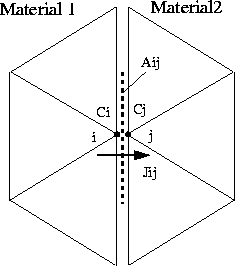From the simulation point of view material interfaces are used to connect the independent segment diffusion models. Normally, the segment diffusion models are specified on one distinct material segment and Neumann boundary conditions are assumed automatically at the segment boundaries. The discretization method is applied for each segment quantity, which leads to a discretized diffusion equation within the global system matrix. With the specification of interface models between two adjacent materials it is possible to connect the discretized segment diffusion equations to get a global description of the diffusion problem. Such an interface model has to be specified between any quantity on either side of the interface.
The interface model results in the definition of either the concentration
values ![]() and
and ![]() on each side of the boundary or the calculation of
a diffusion flux
on each side of the boundary or the calculation of
a diffusion flux ![]() across the boundary (see Fig. 4.4-1).
across the boundary (see Fig. 4.4-1).

Figure 4.4-1: Interface between adjacent material segments. The interface model can be specified by the
concentration values ![]() and
and ![]() on each side of the boundary or by a
diffusion flux
on each side of the boundary or by a
diffusion flux ![]() across
across ![]() .
.
The interface models can depend on quantities which are defined at both sides or only at one side of the boundary. Each interface condition between a boundary point pair i-j results in an additional equation within the global system matrix. It is not necessary to keep these equations in the system, they can be eliminated during assembly of the system matrix by substitution.
Generally, the interface model can be specified by one of the quantities
specified in (4.4-1), where the net-doping ![]() is assumed to
be equal on both sides of the interface.
is assumed to
be equal on both sides of the interface.
We have implemented several material interface models in PROMIS-NT. Their applicability as well as their influence on the dopant concentrations will be discussed in the next sections.